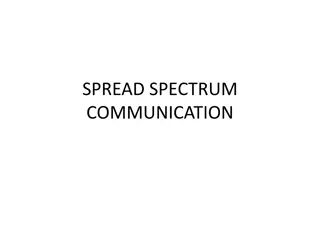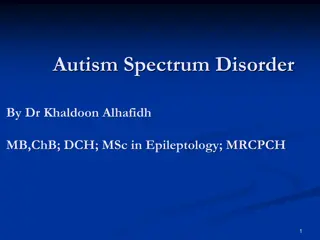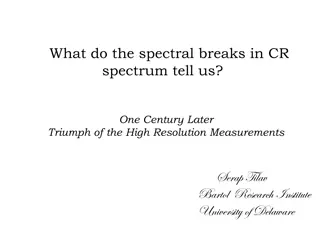Understanding Fluoroquinolones: Mechanism, Spectrum, and Generations
Fluoroquinolones are a class of potent antibiotics that act on DNA gyrase and topoisomerase IV in bacteria, leading to DNA damage and cell division interference. They exhibit a broad spectrum of antimicrobial activity, effective against various bacteria but not ideal for certain infections. Classified into different generations based on targets, they play a crucial role in combating bacterial infections while facing challenges of resistance and adverse effects.
Download Presentation

Please find below an Image/Link to download the presentation.
The content on the website is provided AS IS for your information and personal use only. It may not be sold, licensed, or shared on other websites without obtaining consent from the author. Download presentation by click this link. If you encounter any issues during the download, it is possible that the publisher has removed the file from their server.
E N D
Presentation Transcript
Quinolones, Folic Acid Antagonists, and Urinary Tract Antiseptics
I. FLUOROQUINOLONES Nalidixic acid is the predecessor to all fluoroquinolones, a class of man- made antibiotics. Over 10,000 fluoroquinolone analogs have been synthesized, Fluoroquinolones in use today typically offer greater efficacy, a broader spectrum of antimicrobial activity, and a better safety profile than their predecessors. Unfortunately, fluoroquinolone use has been closely tied to Clostridium difficile infection and the spread of antimicrobial resistance in many organisms (for example, methicillin resistance in staphylococci). The unfavorable effects of fluoroquinolones on the induction and spread of antimicrobial resistance are sometimes referred to as collateral damage, a term which is also associated with third-generation cephalosporins (for example, ceftazidime).
A. Mechanism of action Fluoroquinolones enter bacteria through porin channels and exhibit antimicrobial effects on DNA gyrase (bacterial topoisomerase II) and bacterial topoisomerase IV. Inhibition of DNA gyrase results in relaxation of supercoiled DNA, promoting DNA strand breakage. Inhibitionof topoisomerase IV impacts chromosomal stabilization during cell division, thus interfering with the separation of newly replicated DNA. In gram-negative organisms (for example, Pseudomonas aeruginosa), the inhibition of DNA gyrase is more significant than that of topoisomerase IV, whereas in gram-positive organisms (for example, Streptococcus pneumoniae), the opposite is true. Agents with higher affinity for topoisomerase IV (for example, ciprofloxacin) should not be used for S. pneumoniae infections, while those with more topoisomerase II activity (for example, moxifloxacin) should not be used for P. aeruginosa infections.
B. Antimicrobial spectrum - bactericidal, -effective against gram-negative organisms (Escherichia coli, P. aeruginosa, Haemophilus influenzae), -atypical organisms (Legionellaceae, Chlamydiaceae), -gram-positive organisms (streptococci), -some mycobacteria (Mycobacterium tuberculosis). -Fluoroquinolones are typically not used for the treatment of Staphylococcus aureus or enterococcal infections. They are not effective against syphilis and have limited utility against Neisseria gonorrhoeae due to disseminated resistance worldwide. -Levofloxacin and moxifloxacin are sometimes referred to as respiratory fluoroquinolones, because they have excellent activity against S. pneumoniae, which is a common cause of community-acquired pneumonia (CAP). -Moxifloxacin also has activity against many anaerobes. -Fluoroquinolones are commonly considered alternatives for patients with a documented severe -lactam allergy.
Fluoroquinolones may be classified into generations based on their antimicrobial targets. -First generation: nonfluorinated quinolone nalidixic acid is considered to be, with a narrow spectrum of susceptible organisms. -Second generation: Ciprofloxacin and norfloxacin , because of their activity against aerobic gram-negative and atypical bacteria. In addition, these fluoroquinolones exhibit significant intracellular penetration, allowing therapy for infections in which a bacterium spends part or all of its life cycle inside a host cell (for example, chlamydia, mycoplasma, and mycobacteria). -Third generation: Levofloxacin has increased activity against gram-positive bacteria. -Fourth generation: only moxifloxacin because of its activity against anaerobic and gram- positive organisms.
C. Examples of clinically useful fluoroquinolones 1. Norfloxacin: infrequently prescribed due to poor oral bioavailability and a short half-life. It is effective in treating nonsystemic infections, such as urinary tract infections (UTIs), prostatitis, and infectious diarrhea (unlabeled use). 2. Ciprofloxacin: effective in the treatment of many systemic infections caused by gram-negative bacilli . - Of the fluoroquinolones, it has the best activity against P. aeruginosa and is commonly used in cystic fibrosis patients for this indication. - With 80% bioavailability, the intravenous and oral formulations are frequently interchanged. Although typically dosed twice daily, an extended- release formulation is available for once-daily dosing, which may improve patient adherence to treatment. -effective in treatment of Traveler s diarrhea caused by E. coli as well as typhoid fever caused by Salmonella typhi. - Second-line agent in the treatment of tuberculosis. 3. Levofloxacin: the l-isomer of ofloxacin and has largely replaced it clinically.
broad spectrum of activity, used for prostatitis, skin infections, CAP, and nosocomial pneumonia. Unlike ciprofloxacin, levofloxacin has excellent activity against S. pneumoniae respiratory infections. has 100% bioavailability and is dosed once daily. 4. Moxifloxacin: has enhanced activity against gram-positive organisms (for example, S. pneumoniae) and excellent activity against many anaerobes, although resistance to Bacteroides fragilis has been reported. It has poor activity against P. aeruginosa. Moxifloxacin does not concentrate in urine and is not indicated for the treatment of UTIs. D. Resistance - chromosomal mutations. Cross-resistance exists among the quinolones. The mechanisms responsible for this resistance: include the following: 1. Altered target: Chromosomal mutations in bacterial genes (for example, gyrA or parC) have been associated with a decreased affinity for fluoroquinolones at their site of action. Both topoisomerase IV and DNA gyrase may undergo mutations.
2. Decreased accumulation: Reduced intracellular concentration is linked to: 1) porin channels. involves a decreased number of porin proteins in the outer membrane of resistant cell. 2) Efflux pumps. it pumps the drug out of the cell. E. Pharmacokinetics 1. Absorption: Only 35 - 70% of orally administered norfloxacin is absorbed, compared with 80 - 99% of the other fluoroquinolones. Intravenous and ophthalmic preparations of ciprofloxacin, levofloxacin, and moxifloxacin are available. Ingestion of fluoroquinolones with sucralfate, aluminum- or magnesium containing antacids, or dietary supplements containing Fe or Zn can reduce the absorption. Ca and other divalent cations also interfere with the absorption of these agents. 2. Distribution: Binding to plasma proteins ranges from 10 - 40%. distribute well into all tissues and body fluids, which is one of their major clinical advantages. Levels are high in bone, urine (except moxifloxacin), kidney, and prostatic tissue (but not prostatic fluid), and concentrations in the lungs exceed those in serum. Penetration into cerebrospinal fluid is relatively low except for ofloxacin. Also accumulate in macrophages and polymorphonuclear leukocytes, thus having activity against intracellular organisms.
3. Elimination: Most fluoroquinolones are excreted renally. Therefore, dosage adjustments are needed in renal dysfunction. Moxifloxacin is excreted primarily by the liver, and no dose adjustment is required for renal impairment. F. Adverse reactions -Nausea, vomiting, and diarrhea. -Headache and dizziness or lightheadedness may occur. Thus, patients with central nervous system (CNS) disorders, such as epilepsy, should be treated cautiously with these drugs. Peripheral neuropathy. -Glucose dysregulation (hypoglycemia and hyperglycemia) have also been noted. -Phototoxicity, use sunscreen and avoid excess exposure to sunlight. If phototoxicity occurs, discontinuation of the drug is advisable. -Articular cartilage erosion (arthropathy), observed in immature animals. Therefore, these agents should be avoided in pregnancy and lactation and in children under 18 years of age. [Note: Careful monitoring is indicated in children with cystic fibrosis who receive fluoroquinolones for acute pulmonary exacerbations.] An increased risk of tendinitis or tendon rupture may also occur with systemic fluoroquinolone use. -Moxifloxacin and other fluoroquinolones may prolong the QTc interval and, thus, should not be used in patients predisposed to arrhythmias or taking other medications that cause QT prolongation. -Ciprofloxacin can increase serum levels of theophylline by inhibiting its metabolism, also raise the serum levels of warfarin, caffeine, and cyclosporine.
II. OVERVIEW OF THE FOLATE ANTAGONISTS Enzymes requiring folate-derived cofactors are essential for the synthesis of purines and pyrimidines (precursors of RNA and DNA) and other compounds necessary for cellular growth and replication. Therefore, in the absence of folate, cells cannot grow or divide. To synthesize the critical folate derivative, tetrahydrofolic acid, humans must first obtain preformed folate in the form of folic acid from the diet. In contrast, many bacteria are impermeable to folic acid and other folates and, therefore, must rely on their ability to synthesize folate de novo. The sulfonamides (sulfa drugs) are a family of antibiotics that inhibit de novo synthesis of folate. A second type of folate antagonist trimethoprim prevents microorganisms from converting dihydrofolic acid to tetrahydrofolic acid, with minimal effect on the ability of human cells to make this conversion. Thus, both sulfonamides and trimethoprim interfere with the ability of an infecting bacterium to perform DNA synthesis. Combining the sulfonamide sulfamethoxazole with trimethoprim (the generic name for the combination is cotrimoxazole) provides a synergistic combination.
III. SULFONAMIDES The sulfa drugs are seldom prescribed alone except in developing countries, where they are still employed because of their low cost and efficacy. A. Mechanism of action In many microorganisms, dihydrofolic acid is synthesized from p-aminobenzoic acid (PABA), pteridine, and glutamate. All the sulfonamides currently in clinical use are synthetic analogs of PABA. Because of their structural similarity to PABA, the sulfonamides compete with this substrate for the bacterial enzyme, dihydropteroate synthetase. They thus inhibit the synthesis of bacterial dihydrofolic acid and, thereby, the formation of its essential cofactor forms. The sulfa drugs, including cotrimoxazole, are bacteriostatic. B. Antibacterial spectrum Sulfa drugs are active against select Enterobacteriaceae in the urinary tract and Nocardia infections. In addition, sulfadiazine in combination with the dihydrofolate reductase inhibitor pyrimethamine is the preferred treatment for toxoplasmosis. Sulfadoxine in combination with pyrimethamine is used as an antimalarial drug. C. Resistance -Bacteria that can obtain folate from their environment are naturally resistant to these drugs. -Acquired bacterial resistance to the sulfa drugs can arise from plasmid transfers or random mutations. [Note: Organisms resistant to one member of this drug family are resistant to all.] Resistance is generally irreversible and may be due to: 1)an altered dihydropteroate synthetase. 2) decreased cellular permeability to sulfa drugs, or 3) enhanced production of the natural substrate, PABA.
D. Pharmacokinetics 1. Absorption: After oral administration, most sulfa drugs are well absorbed. An exception is sulfasalazine It is not absorbed when administered orally or as a suppository and, therefore, is reserved for treatment of chronic inflammatory bowel disease (for example, ulcerative colitis). [Note: Local intestinal flora split sulfasalazine into sulfapyridine + 5- aminosalicylate, with the latter exerting the anti-inflammatory effect. Absorption of sulfapyridine can lead to toxicity in patients who are slow acetylators.] Intravenous sulfonamides are generally reserved for patients who are unable to take oral preparations. Because of the risk of sensitization, sulfa drugs are not usually applied topically. However, in burn units, creams of silver sulfadiazine or mafenide acetate ( -amino-p-toluene sulfonamide) have been effective in reducing burn-associated sepsis because they prevent colonization of bacteria. [Note: Silver sulfadiazine is preferred because mafenide produces pain on application and its absorption may contribute to acid base disturbances.] 2. Distribution: Sulfa drugs are bound to serum albumin in the circulation, where the extent of binding depends on the ionization constant (pKa) of the drug. In general, the smaller the pKa value, the greater the binding. Sulfa drugs distribute throughout the bodily fluids and penetrate well into cerebrospinal fluid even in the absence of inflammation. They can also pass the placental barrier and enter fetal tissues. 3. Metabolism: The sulfa drugs are acetylated and conjugated primarily in the liver. The acetylated product is devoid of antimicrobial activity but retains the toxic potential to precipitate at neutral or acidic pH. This causes crystalluria stone formation and, therefore, potential damage to the kidney. 4. Excretion: Sulfa drugs are eliminated by glomerular filtration and secretion and require dose adjustments for renal dysfunction. Sulfonamides may be eliminated in breast milk.
E. Adverse effects 1. Crystalluria: Nephrotoxicity may develop as a result of crystalluria. Adequate hydration and alkalinization of urine can prevent the problem by reducing the concentration of drug and promoting its ionization. 2. Hypersensitivity: Hypersensitivity reactions, such as rashes, angioedema or Stevens- Johnson syndrome, may occur. When patients report previous sulfa allergies, it is paramount to acquire a description of the reaction to direct appropriate therapy. 3. Hematopoietic disturbances: Hemolytic anemia is encountered in patients with glucose- 6-phosphate dehydrogenase (G6PD) deficiency. Granulocytopenia and thrombocytopenia can also occur. Fatal reactions have been reported from associated agranulocytosis, aplastic anemia, and other blood dyscrasias. 4. Kernicterus: This disorder may occur in newborns, because sulfa drugs displace bilirubin from binding sites on serum albumin. The bilirubin is then free to pass into the CNS, because the blood brain barrier is not fully developed. 5. Drug potentiation: Transient potentiation of the anticoagulant effect of warfarin results from the displacement from binding sites on serum albumin. Serum methotrexate levels may also rise through its displacement. 6. Contraindications: Due to the danger of kernicterus, sulfa drugs should be avoided in newborns and infants less than 2 months of age, as well as in pregnant women at term. Sulfonamides should not be given to patients receiving methenamine, since they can crystallize in the presence of formaldehyde produced by this agent.
IV. TRIMETHOPRIM Apotent inhibitor of bacterial dihydrofolate reductase, exhibits an antibacterial spectrum similar to that of the sulfonamides. Trimethoprim is most often compounded with sulfamethoxazole, producing the combination called cotrimoxazole. A. Mechanism of action The active form of folate is the tetrahydro derivative that is formed through reduction of dihydrofolic acid by dihydrofolate reductase. This enzymatic reaction is inhibited by trimethoprim, leading to a decreased availability of the tetrahydrofolate cofactors required for purine, pyrimidine, and amino acid synthesis. The bacterial reductase has a much stronger affinity for trimethoprim than does the mammalian enzyme, which accounts for the selective toxicity of the drug. B. Antibacterial spectrum The antibacterial spectrum of trimethoprim is similar to that of sulfamethoxazole. However, trimethoprim is 20 - 50-fold more potent than the sulfonamides. Trimethoprim may be used alone in the treatment of UTIs and in the treatment of bacterial prostatitis (although fluoroquinolones are preferred). C. Resistance -Resistance in gram-negative bacteria is due to the presence of an altered dihydrofolate reductase that has a lower affinity for trimethoprim. -Efflux pumps and decreased permeability to the drug . D. Pharmacokinetics Trimethoprim is rapidly absorbed following oral administration. Because the drug is a weak base, higher concentrations of trimethoprim are achieved in the relatively acidic prostatic and vaginal fluids. The drug is widely distributed into body tissues and fluids, including penetration into the cerebrospinal fluid. Trimethoprim undergoes some O-demethylation, but 60 - 80% is renally excreted unchanged.
E. Adverse effects Trimethoprim can produce the effects of folic acid deficiency. These effects include megaloblastic anemia, leukopenia, and granulocytopenia, especially in pregnant patients and those having very poor diets. These blood disorders may be reversed by the simultaneous administration of folinic acid, which does not enter bacteria. V. COTRIMOXAZOLE The combination of trimethoprim + sulfamethoxazole, called cotrimoxazole, shows greater antimicrobial activity than equivalent quantities of either drug used alone. The combination was selected because of the synergistic activity and the similarity in the half-lives of the two drugs. A. Mechanism of action The synergistic antimicrobial activity of cotrimoxazole results from its inhibition of two sequential steps in the synthesis of tetrahydrofolic acid. Sulfamethoxazole inhibits the incorporation of PABA into dihydrofolic acid precursors, and trimethoprim prevents reduction of dihydrofolate to tetrahydrofolate. B. Antibacterial spectrum Cotrimoxazole has a broader spectrum of antibacterial action than the sulfa drugs alone. It is effective in treating UTIs and respiratory tract infections, as well as Pneumocystis jirovecii pneumonia (PCP), toxoplasmosis, and ampicillin- or chloramphenicol-resistant salmonella infections. It has activity against MRSA and can be particularly useful for community-acquired skin and soft tissue infections caused by this organism. It is the drug of choice for infections caused by susceptible Nocardia species and Stenotrophomonas maltophilia. C. Resistance Resistance to the trimethoprim sulfamethoxazole combination is less frequently encountered than resistance to either of the drugs alone, because it requires that the bacterium have simultaneous resistance to both drugs. Significant resistance has been documented in a number of clinically relevant organisms, including E. coli and MRSA.
D. Pharmacokinetics Cotrimoxazole is generally administered orally. Intravenous administration may be utilized in patients with severe pneumonia caused by PCP. Both agents distribute throughout the body. Trimethoprim concentrates in the relatively acidic milieu of prostatic fluids, and this accounts for the use of trimethoprim sulfamethoxazole in the treatment of prostatitis. Cotrimoxazole readily crosses the blood brain barrier. Both parent drugs and their metabolites are excreted in the urine. E. Adverse effects Skin reactions especially in the elderly, nausea and vomiting, glossitis and stomatitis, hyperkalemia especially with higher doses, megaloblastic anemia, leukopenia, and thrombocytopenia may be fatal. The hematologic effects may be reversed by the concurrent administration of folinic acid, which protects the patient and does not enter the microorganism. Hemolytic anemia may occur in patients with G6PD deficiency due to the sulfamethoxazole component. Immunocompromised patients with PCP frequently show drug-induced fever, rashes, diarrhea, prothrombin times (increased INR) in patients receiving both sulfamethoxazole and warfarin (monitoring). The plasma half-life of phenytoin may be increased due to inhibition of its metabolism. Methotrexate levels may rise due to displacement from albumin-binding sites by sulfamethoxazole. and/or pancytopenia. Prolonged
VI. URINARY TRACT ANTISEPTICS/ANTIMICROBIALS UTIs are prevalent in women of child-bearing age and in the elderly population. E. coli is the most common pathogen, causing about 80% of uncomplicated upper and lower UTIs. Staphylococcus saprophyticus is the second most common bacterial pathogen causing UTIs. In addition to cotrimoxazole and the quinolones previously mentioned, UTIs may be treated with any one of a group of agents called urinary tract antiseptics, including methenamine, nitrofurantoin, and the quinolone nalidixic acid. These drugs do not achieve antibacterial levels in the circulation, but because they are concentrated in the urine, microorganisms at that site can be effectively eradicated. A. Methenamine 1. Mechanism of action: decomposes at an acidic pH of 5.5 or less in the urine, thus producing formaldehyde, which acts locally and is toxic to most bacteria. Bacteria do not develop resistance to formaldehyde, which is an advantage of this drug. [Note: Methenamine is frequently formulated with a weak acid (for example, mandelic acid or hippuric acid) to keep the urine acidic. The urinary pH should be maintained below 6. Antacids, such as sodium bicarbonate, should be avoided.] 2. Antibacterial spectrum: is primarily used for chronic suppressive therapy to reduce the frequency of UTIs. Routine use in patients with chronic urinary catheterization to reduce catheter associated bacteriuria or catheter-associated UTI is not generally recommended. should not be used to treat upper UTIs (for example, pyelonephritis). Urea-splitting bacteria that alkalinize the urine, such as Proteus species, are usually resistant to the action of methenamine. 3. Pharmacokinetics: is administered orally. In addition to formaldehyde, ammonium ions are produced in the bladder. Because the liver rapidly metabolizes ammonia to form urea, methenamine is contraindicated in patients with hepatic insufficiency, as ammonia can accumulate.
Distributed throughout the body fluids, but no decomposition of the drug occurs at pH 7.4. Thus, systemic toxicity does not occur, and the drug is eliminated in the urine. 4. Adverse effects: Gastrointestinal distress, at higher doses, albuminuria, hematuria, Methenamine mandelate is contraindicated in patients with renal insufficiency, because mandelic acid may precipitate. [Note: Sulfonamides, such as cotrimoxazole, react with formaldehyde and must not be used concomitantly with methenamine. The combination increases the risk of crystalluria and mutual antagonism.] B. Nitrofurantoin Sensitive bacteria reduce the drug to a highly active intermediate that inhibits various enzymes and damages bacterial DNA. It is useful against E. coli, but other common urinary tract gram-negative bacteria may be resistant. Grampositive cocci (for example, S. saprophyticus) are typically susceptible. Hemolytic anemia may occur with nitrofurantoin use in patients with G6PD deficiency. Other adverse effects include gastrointestinal disturbances, acute pneumonitis, and neurologic problems. Interstitial pulmonary fibrosis has occurred in patients who take nitrofurantoin chronically. The drug should not be used in patients with significant renal impairment or women who are 38 weeks or more pregnant.























